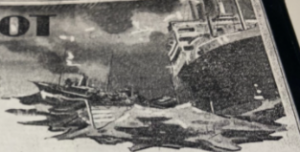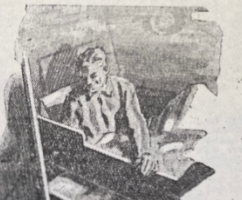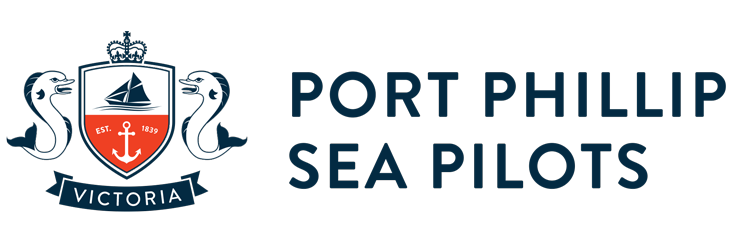11 Jun ” Never keep a vessel waiting ” is the slogan of the Pilot Service

There is a fascination about the work of a pilot, which all lovers of the sea recognised. The writer of this article describes his little-known daily routine and shows that these winter days there are more comfortable occupations than boarding of a big liner outside the Heads and bound for Melbourne Port.
During these chilly days and nights there are no section of the community which comes in for a larger share of buffeting from the elements than the 20 experts’ seamen who guide our shipping up and down the Bay, and whose job compels them to endure, between whiles, the cold discomfort of tossing about in their lively little pilot vessel which mounts guard three or four miles outside Port Phillip Heads.
Like the ebb and flow of the tides, vessels arrive in our port from all the world, pause for a brief space, and depart again upon the ocean highway. Crowds gather on the quayside to welcome friends from overseas; and, amidst the cheers and the tears and the fluttering of rainbow-coloured streamers, more crowds gathered to watch their loved ones sail away.
In all these comings and goings, the pilot plays a part. Let us peep behind the scenes for a few moments to see and get his cue and take the stage …
The 14 Williamstown and six Queenscliff pilots come on turn for duty on a regular roster system, kept in the Pilot Office, Williamstown. At 9:00 AM each day the boatman on duty at the Pilot Office telephones something like this:-

“Charlie speaking Sir… you’re six on turn.. three ships have applied for sea…one for Geelong and two others, are likely to go late. You’ll be for the “Antimacassar” probably…I’ll ring you later sir ” Good! there will be some time to dig up the potato patch. An hour later the telephone rings again. “Position’s changed, sir…The “Washtub’s” applied to come up from Geelong at 5:00 p.m….A pilot will be wanted for 1:30 p.m. train from town, sir ” etc. etc.
All right… But another ring comes half an hour later. ” Orders just come in from the ‘Foolscap Maru’ to shift off at once from Gellibrand Pier to an anchorage in the Bay… That’ll be you sir; all the other ships have applied for sea ”
Humph ” In his haste the pilot cut his chin shaving, dresses at top speed and dashes off to attend the Japanese ship. It’s dirty weather out in the Bay, with a nasty southerly. When he comes ashore again, he finds he is on his turn for the Orient Mail leaving at 4:00 p.m. That means 3:00 p.m. at the Pilot Office.
He returns home, has a snack of lunch, rushes back to the pilot office, and the boatman takes him across the Port Melbourne in the launch. He reaches the liner’s bridge to schedule – half an hour before sailing time.
“Eight Bells” strikes, and the gangways are hauled ashore.
“
All right, Pilot; carry on, please” says the captain.
The Telegraphs clang, the lines are cast off, and the Blue Peter comes fluttering down.
The huge vessel backs round from the pier and steams down the Bay in the teeth of the Gale. The cold is intense, and the icy sprays come over the bows. Darkness soon sets in. In two hours’, time the ship turns into the South Channel, and a vicious squall blots out the all the channel lights. The engines are put to “slow” …luckily the rain clears as a squall passes north. The pilot sights Portsea gas buoy light. “Full ahead” he orders. Lonsdale light shows dimly on the port bow. Can he get outside before the next squall works up? It is just possible. With the ebb tide the ship is making about 18 knots…
What’s that in the heads? Some coaster stuck in the tide. Will she “sheer” across the fairway?
With the engines at standby the ship swings round for the Heads, keeping Queenscliff leading lights in line astern. She whizzes past the tide-bound Collier. There’s a heavy sea rolling in and the ebb tide is rushing out to meet it. The big ship heaves. And nasty-looking line of breakers looms up in the black void ahead. She dives and her bows are smothered in spray.
The “half speed” reply from the engine room sounds like a crash of broken glass. The vessel plunges into the rip and the wind screams through the signal halyards like fiends let loose.
Beneath Point Lonsdale double flashes, a feeble light flickers out “What ship is that”?
The answering flashes from the morse light on the bridge show up vividly the angry swirl of the Rip. There’s about a 43 foot of water covering the rocky bar, and the ship is drawing over 28 feet and “sounding” 10 to 12 feet!
Once clear of the heads the seas run truer, but it is heavy enough. The distinguishing lights of the pilot vessel white and red appear intermittently in the blackness ahead. The liner of forges through the sea towards her and presently reduces speed and stops- rolling steadily. The pilot vessel plunges close around that big ships turn.
“Well good night pilot” says the captain shaking his hands ” You can have your job wouldn’t tackle it for 5000 a year “. Accompanied by the quartermaster, carrying his bag the pilot descends the bridge ladders and his whisked down several decks in the lift, emerging into a spacious vestibule, through the glass doors of which he has a passing glimpse of the gay throng of men and women attired in evening dress at dinner in brilliantly lighted saloon. He pokes his head out of the opened side door. Whew! what contrast!
Sheets the spray fly over the pilot vessel as she lurches under the liner’s lee. How small she looks! She drops a boat into the water and the two men at the oars struggle across between the ships. These boatmen are out on their own at this work.
The pilot clinging to the swaying rope ladder watches his chances and drops into the boat as it rises on the crest of the sea. They push off soon reaching the pilot vessel, and as she rolls over nearly on her beam ends, the pilot jumps nimbly onto the sloping deck and scrambles up to the bridge ladder. “Good evening captain” he says shaking hands “rotten sea” (Each pilot in turn is captain of the vessel for a week ) ” yes, but it was worse last night ” he replies. Keeping a watchful eye on the men as they skilfully hook the boat on and hoist it up in the davits. Then he said shortly “got the Herald? ”
” Never keep a vessel waiting ” is a slogan in the Pilot Service. Shipmasters visiting Melbourne know this and approach the station confident of picking up a pilot at once.
“Boarding” vessels however is always a risky proceeding. Captains of the outbound ships sometimes try to dissuade pilots from venturing in the little boat but only on rare occasions have they been over carried. Accidents of course will occur. Once when a pilot was descending the ladder of the high side of vessel someone on deck let go the man ropes in mistake for the boat rope thereby causing the pilot to lose his grip. Fortunately, a powerfully built pilot happened to be in the waiting boat below and quick as lightning, he braced himself up to break the fall. This he did, and although both men were badly bruised and shaken the prompt action was the means of saving a valuable life.
……
The Herald Saturday evening June the 11th 1932

